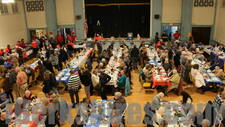iBerkshires.com Columnist SectionSue Bush
More articles from Sue Bush
EMS: Courage And Compassion In ActionBy Shawn Godfrey
07:01AM / Monday, April 30, 2007
 | | Shawn Gidfrey is a certified paramedic and operations manager for the Village Ambulance Service. |
That’s Gotta Sting!
With spring finally here it’s important to be prepared for a wide variety of allergies, including bee stings. And if you’re like me, the mere site of a bee will cause you to run to the hills screaming like a frightened schoolgirl. There, I said it.
Being stung by a bee is painful and, for some people, a potentially dangerous experience. The intensity of discomfort felt by the victim depends on the bee’s breed, the anatomical location of the bee sting, and the victim’s sensitivity to the venom contained in the bee’s stinger.
To Bee Or Not To Bee
According to Wikipedia.org, a bee sting strictly means a sting from a bee (honeybee, bumblebee, sweat bee, etc). In the vernacular it can mean a sting of a bee, wasp, hornet, yellow jacket or sawfly. Some people may even call the bite of a horsefly a bee sting. It is important to differentiate a bee sting from an insect bite. It is also important to recognize that the venom or toxin of stinging insects is quite different. Therefore, the body's reaction to a bee sting may differ significantly from one species to another.
The most aggressive stinging insects are wasps (including bald-faced hornets) but hornets (the European hornet is gentle)are generaly not aggressive. However, all of these insects aggressively defend their nests, although they have not developed a sting targeted at mammals as the honeybees have done.
A Deadly “Pointâ€
In people who are allergic to bees, a sting can easily trigger a dangerous or deadly anaphylactic reaction.
The signs and symptoms of an anaphylactic reaction may include, but are not limited to, hives, shortness of breath, tightness or discomfort in the victim’s throat/chest, confusion, loss of consciousness, and nausea and vomiting.
Depending on the victim’s allergy threshold, these signs and symptoms can occur minutes or even seconds after the initial sting and usually necessitate immediate emergency medical intervention.
Treatment
* Move yourself or the victim away from the bee(s)! When threatened, a bee can release a warning scent in order to attract other bees as allies; additional bees may lead to additional stings!
* It is important to watch the bee sting victim for any signs of an anaphylactic reaction.
Many people who are prone to an anaphylactic reaction often carry a portable medication auto-injector that can be self-administered. The injector contains a spring-loaded needle that shoots through a port in the tip and into the recipient's body (typically a large muscle like the quadriceps) to deliver epinephrine.
Epinephrine is a medication that inhibits your body from releasing chemicals that may cause an allergic reaction. Along with relieving the aforementioned signs and symptoms of an anaphylactic reaction, epinephrine also helps to maintain a normal blood pressure and reduce swelling in the victim’s eyelids, hands, feet, tongue, and throat.
* Immediately locating and removing the bee’s stinger from the skin is extremely important! If left embedded, the venom from a bee’s stinger will continue to secrete into the skin, subsequently exacerbating the effected area and, in anaphylactic cases, the overall condition of the victim.
After the stinger is located, it should be removed with tweezers. Pinch the area around the sting site so that the stinger rises above the skin’s surface and pull it out with the tweezers.
* Once the stinger is removed, apply ice or a cold compress to the sting site. This may help alleviate any associated pain and/or swelling.
* There are also many commercial bee sting treatment products available on the market. When you or a loved one are engaged in activities away from home, having these products readily available may be beneficial.
Prevention
Ways to avoid bee stings may include the following:
* Avoid known areas of high bee hive and nest concentration.
* Do not bother inactive hives or nests, or assume some nests are “empty.â€
* Refrain from swatting at bees or other flying insects.
* While working outdoors, be sure to wear long pants and long–sleeved shirts.
* Keep outdoor dining areas clean and free from rubbish.
* Look for ground nests when mowing grass. Mowing over a nest will create hostile bees.
The Importance of Time
Even if the patient fully recovers following an epinephrine injection, it is essential to call for immediate emergency medical intervention for all suspected or proven anaphylactic reactions. Many of these victims require further in-hospital care consisting of cardiac monitoring, blood work analysis, or additional breathing treatment(s).
A delay in emergency medical intervention greatly increases the risk of a person having a severe allergic reaction. In some people, serious illness or even death may occur despite appropriate emergency medical care.
|
| Isnt it funny that the people that are deathly allergic to bees never carry their epipen around with them????? Good look ahead with the weather changing to the summer season. | | from: MidnightMedicine | on: 05-03 00:00:00-2007 |
|
| Very informative , I didn't know removing the stinger was that important. I look forward to next weeks. thanks.... | | from: bernie | on: 05-02 00:00:00-2007 |
|
| Great articles, Shawn. You're providing good, up to date information that will hopefully make all of our jobs that much easier! | | from: Tara | on: 05-01 00:00:00-2007 |
|
| My mom used to put a pasty mix of water and baking soda on a bee sting until it dried to supposedly reduce swelling and help a stinger work its way out. I don't remember how effective this old cure was, but I do remember how much the bee sting hurt!! Little buggers. I have also heard of people GETTING bee stings to help with certain ailments. Any info on either, Shawn? Your smart so maybe you have an answer... looking forward to your next article!! | | from: aurora | on: 05-01 00:00:00-2007 |
|
I agree with Tim that it is a good article, however, I disagree with simply using a "credit card" to scrape the stinger away. There is a lot of data to support that simply "scraping" the stinger away does not dislodge it fully. Research a variety of internet sites for more information.
Hasta La Vista... | | from: Jorge | on: 05-01 00:00:00-2007 |
|
| Here in canada it is not taught to use twezzers while removing a stinger, instead you should scrape the stinger away,using for example a credit card. overall Great article...... | | from: Tim | on: 04-30 00:00:00-2007 |
|
| Shawn another great info article. With spring and summer coming bees will on be on the sting, so WATCH OUT. Keep it up, read ya next week. | | from: Chuck | on: 04-30 00:00:00-2007 |
|
| Hello iberkshires. Shawn (whom I do not know personally) has written another informative article. His eagerness to help the community should not go unnoticed. | | from: Stephan | on: 04-30 00:00:00-2007 |
|
| It's either coincidental or you are just hitting your audience at that right time! Great job! I'm allergic to bees and found this column extremely informative. | | from: Gene | on: 04-30 00:00:00-2007 |
|
| Hey Shawn!! I HATE BEES!!! I am allergic and my lifeline is my Epipen. It seems that more children are allergic! As a school bus driver I have been trained to administer the medicine to children who have been stung and are allergic. It is important to know that the effects of the epinephrine are short lived and it is necessary to get professional help immediately. Great article!! ;) | | from: gold duece girl | on: 04-30 00:00:00-2007 |
|
|
Advertise on
iBerkshires.com
|



















